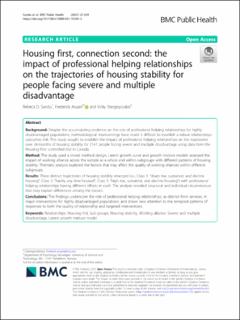| dc.contributor.author | Sandu, Rebeca D. | |
| dc.contributor.author | Anyan, Frederick | |
| dc.contributor.author | Stergiopoulos, Vicky | |
| dc.date.accessioned | 2021-02-01T12:23:13Z | |
| dc.date.available | 2021-02-01T12:23:13Z | |
| dc.date.created | 2021-01-30T15:22:30Z | |
| dc.date.issued | 2021 | |
| dc.identifier.citation | BMC Public Health. 2021, 21 1-15. | en_US |
| dc.identifier.issn | 1471-2458 | |
| dc.identifier.uri | https://hdl.handle.net/11250/2725571 | |
| dc.description.abstract | Background: Despite the accumulating evidence on the role of professional helping relationships for highly disadvantaged populations, methodological shortcomings have made it difficult to establish a robust relationshipsoutcomes link. This study sought to establish the impact of professional helping relationships on the trajectories over 24 months of housing stability for 2141 people facing severe and multiple disadvantage using data from the Housing First controlled trial in Canada. Method: The study used a mixed method design. Latent growth curve and growth mixture models assessed the impact of working alliance across the sample as a whole and within subgroups with different patterns of housing stability. Thematic analysis explored the factors that may affect the quality of working alliances within different subgroups. Results: Three distinct trajectories of housing stability emerged (i.e., Class 1: “sharp rise, sustained, and decline housing”; Class 2: “hardly any time housed”; Class 3: “high rise, sustained, and decline housing”) with professional helping relationships having different effects in each. The analysis revealed structural and individual circumstances that may explain differences among the classes. Conclusions: The findings underscore the role of professional helping relationships, as distinct from services, in major interventions for highly disadvantaged populations, and draws new attention to the temporal patterns of responses to both the quality of relationship and targeted interventions. Keywords: Relationships, Housing first, Sub-groups, Housing stability, Working alliance, Severe and multiple disadvantage, Latent growth mixture model | en_US |
| dc.language.iso | eng | en_US |
| dc.publisher | BMC | en_US |
| dc.rights | Navngivelse 4.0 Internasjonal | * |
| dc.rights.uri | http://creativecommons.org/licenses/by/4.0/deed.no | * |
| dc.title | Housing first, connection second: the impact of professional helping relationships on the trajectories of housing stability for people facing severe and multiple disadvantage | en_US |
| dc.type | Peer reviewed | en_US |
| dc.type | Journal article | en_US |
| dc.description.version | publishedVersion | en_US |
| dc.source.pagenumber | 1-15 | en_US |
| dc.source.volume | 21 | en_US |
| dc.source.journal | BMC Public Health | en_US |
| dc.identifier.doi | https://doi.org/10.1186/s12889-021-10281-2 | |
| dc.identifier.cristin | 1883309 | |
| dc.description.localcode | © The Author(s). 2021 Open Access This article is licensed under a Creative Commons Attribution 4.0 International License, which permits use, sharing, adaptation, distribution and reproduction in any medium or format, as long as you give appropriate credit to the original author(s) and the source, provide a link to the Creative Commons licence, and indicate if changes were made. The images or other third party material in this article are included in the article's Creative Commons licence, unless indicated otherwise in a credit line to the material. If material is not included in the article's Creative Commons licence and your intended use is not permitted by statutory regulation or exceeds the permitted use, you will need to obtain permission directly from the copyright holder. To view a copy of this licence, visit http://creativecommons.org/licenses/by/4.0/. The Creative Commons Public Domain Dedication waiver (http://creativecommons.org/publicdomain/zero/1.0/) applies to the data made available in this article, unless otherwise stated in a credit line to the data. | en_US |
| cristin.ispublished | true | |
| cristin.fulltext | original | |
| cristin.qualitycode | 1 | |

